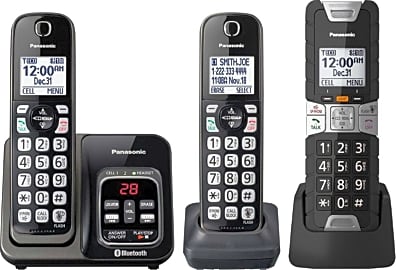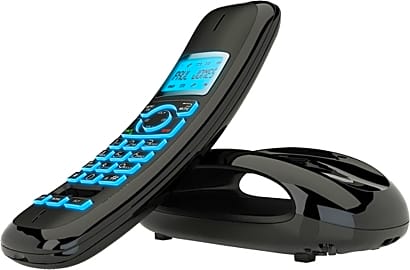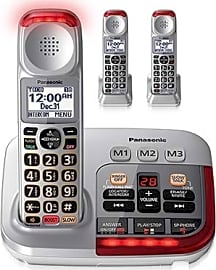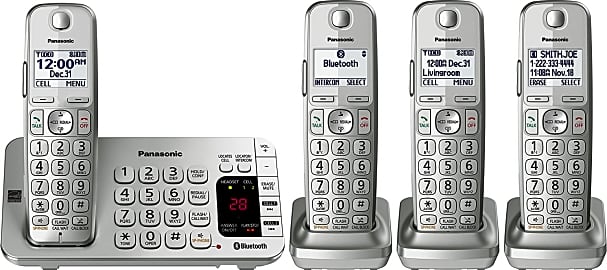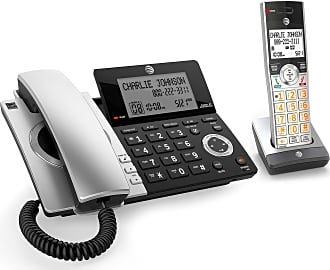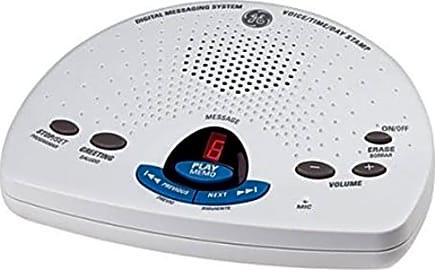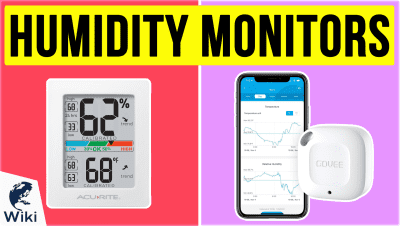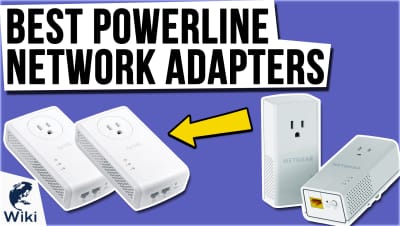The 10 Best Answering Machines

This wiki has been updated 35 times since it was first published in May of 2016. While younger generations primarily use smartphones these days and rarely listen to their voicemails, many older people still prefer a landline with an answering machine. These handy devices will record telephone messages and play them back at your convenience. Many also come with useful features, like adjustable volume control, caller ID, and bright screens with large, easy-to-read text. When users buy our independently chosen editorial recommendations, we may earn commissions to help fund the Wiki.
Editor's Notes
January 25, 2021:
Advancements in connectivity and communication technology have reduced the necessity to nave a stand-alone answering machine, however, there is still a certain demographic who find them useful, if not preferable to a voicemail service provided by a mobile phone company. For example, seniors who do not own or know how to use a smartphone, busy families, who can use their various functions to leave memos for each other, and businesses that still function using a landline.
In this update, it was found that all of the selections in this wiki are still current and up to date, with some of the most prominent telecommunications companies providing digital models with advanced features, such as the Panasonic KX-TGD532W, which comes with two handsets each with their own recharging bases, and personalized ringtones for family and friends, or the AT&T CL84107, which can store over 20 minutes worth of voice recording and features high-contrast, backlit LCDs and illuminated keypads.
December 24, 2019:
If you still use your land line phone, you’ll surely need one with a reliable answering machine so you don’t miss any of your important messages when you’re out. Our list features models that are incorporated into the phone unit as well as some standalone choices like the AT&T 1740 and the Thomson GE Digital.
Several older models are replaced with newer ones in this update, including the VTech DS6151 DECT 6.0, which now features headsets with bright blue light-up screens that are easy to read in the dark, as well as a sleek, silver and black design. You can see who’s calling and access the menus from either the base or the two cordless handsets.
The updated Panasonic Bluetooth Cordless can come in handy for busy families, since you can link it with up to two smartphones, and one of the 3 handsets has a built-in flashlight, padded bumpers, and waterproof construction, making it suitable to be placed in the backyard when you’re outside. (It’ll even float in a pool.) It’s compatible with Siri and Google Now, so you can have the phone place a call with just a simple voice command. For a more basic Panasonic model, yet one that’s been given some enhancements, look to the Panasonic Amplified, which lets you slow down the playback of messages when callers talk too quickly, and its talking keypad comes in handy for anyone with visual impairment.
The AT&T CL84107 gives you the best of both worlds, with a corded and a cordless handset, and both boast high-contrast, backlit LCDs and lighted keypads. A quick glance at either screen will tell you the time and date. Another model that now comes with both types of handset is the Clarity E814CC Amplified, which is a nice option for the hearing impaired, thanks to its highly adjustable call, ring, and message playback volumes.
A new addition to the list is the Idect Solo Plus, which combines a retro look with modern technology, with a backlit keypad and caller ID that stores up to 30 names and numbers. It features an attractive, curved design in white, black, or striking metallic red.
Leave A Message After The Beep
The tape is often incorporated into the phone housing itself.
When you're not home to take a call and you don't feel like being tied to your cell phone at every minute, a physical answering machine can be a great asset. Such a device both prevents you from being glued to technology while being certain that you don't miss important calls from people with whom you'll later need to get in touch.
In the traditional sense, an answering machine is a physical telephone answering device (or TAD) connected to a landline phone that is dedicated to recording a voice message from an incoming caller for playback at a later time. After a certain number of rings, the machine automatically answers the phone with a pre-recorded message (or greeting) to the caller alerting them to your absence. Typically, this pre-recorded greeting can be customized so that a caller hears your own voice instead of an automatic one. Once the pre-recorded message has completed, the caller is then allowed to leave their own message for future playback. It can then be deleted or recorded over, depending on the type of machine being used.
The telephone answering device is slightly different from the concept of voicemail, given that voicemail represents a centralized and networked solution for recording messages, whereas the telephone answering device is connected through an actual phone line. That being said, the underlying concept of both voicemail and answering machines is the same, to inform a caller of your absence and allow them to leave you a detailed message in return. Machine and voicemail services can be applied to both professional and personal situations. However, voicemail systems are typically set up for smartphone users and large businesses with a high influx of inquiries by phone and dedicated customer service staff to respond to messages being left.
Answering machines fall into two major categories: digital and tape-based. The tape-style answering machine is the oldest of the two and leverages a two-sided cassette tape onto which messages may be recorded, erased, and re-recorded. The tape is often incorporated into the phone housing itself. Because the tape machine uses physical media to record messages, there is a finite amount of audio data that can be stored. To play back or repeat messages, the landline owner must manually play, pause, and rewind the tape in order to hear the message content. If the user no longer needs to retain the messages, the tape can be rewound back to the beginning and used again to record a new set of messages.
Tape-based machines can be equipped with either one or two cassettes. On a double-cassette machine, one of the cassettes is dedicated to playing an outgoing greeting message that a caller hears after a certain number of rings, while the second tape is used to record incoming messages once the outgoing greeting has completed. With a single-cassette machine, both the greeting and incoming messages are stored on the same tape.
Digital answering machines (also knows as digital answering services) are electronic devices connected to a landline telephone with the ability to store recorded messages to an internal memory chip. The chip keeps track of the exact date and time of the calls as well as the messages themselves, removing the need for tape and providing a more reliable message storage service. It's also more difficult to fill up digital machine memory since physical storage tape has been removed from the equation.
Choosing Your Services
Finding the best answering machine for your needs really comes down to a matter of context and communication. For example, if you're a business owner with the necessity to refer back to messages without having to worry about rewinding tape over and over, then a digital machine is clearly the right choice. Not only are many digital machines integrated into a charging station attached to a cordless phone, but they offer greater storage capacity along with more bells and whistles that you won't find on older tape machines.
Some of the best digital machines can save up to 50 numbers in their recent call histories or up to 60 minutes of voice message space with their internal memory.
Random-access memory (RAM) is a large advantage when choosing a digital answering machine, so one must be sure to find a model with enough storage to accommodate as many incoming messages as possible. Some of the best digital machines can save up to 50 numbers in their recent call histories or up to 60 minutes of voice message space with their internal memory. The digital machine takes a caller's message and converts it into a stream of bytes while its micro-controller digitizes the caller's voice using an analog-to-digital converter and then stores the message in the machine's low-power RAM.
Many of these machines also allow for remote access to saved messages, which is especially convenient when traveling or running a business that requires checking on missed calls when you aren't in your office.
For large families, digital answering machines offer an additional advantage of having separate mailboxes that can be accessed by the caller with voice prompts. This way, each member of the family can access their own voice messages without having to listen to others, so this is definitely an important feature to consider when making a purchase.
A Brief History Of Answering Machines
The earliest telephone answering machines leveraged magnetic recording technology, which was first utilized by Danish inventor and engineer Valdemar Poulsen in 1898. By 1890, Poulsen patented the telegraphone, which was a device used to record sound on a steel wire or tape. He later designed a model to answer the telephone automatically and record a message. Poulsen's invention has been credited with having laid the foundation for today’s audio recording industry, also making him one of the major contributing factors to the development of the audio cassette, the CD, and DVD technology.
This machine used a record player for announcements and a wire recorder for both message capture and playback.
In 1914, Thomas Edison invented the telescribe machine, which combined the use of a telephone with the dictating phonograph, thus allowing for the recording of both sides of a telephone conversation using wax cylinders.
By 1949, the first commercially successful answering machine was the Electronic Secretary, which was invented by Joseph Zimmerman and businessman George W. Danner, founders of Electronic Secretary Industries in Wisconsin. This machine used a record player for announcements and a wire recorder for both message capture and playback.
Fast forward to the mid-1980s to the restructuring of the American Telephone and Telegraph Company (AT&T) when answering machines became more widely used and affordable in the United States. The first fully digital answering machines also came about around the same time. Today, answering machines are available in many forms, including those voicemail services available on mobile phones, video phones, and landlines connected to base stations with cordless phones equipped with their own integrated machines for storing messages without the use of magnetic tapes.




